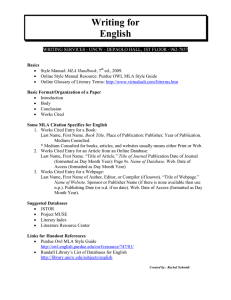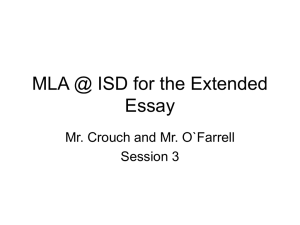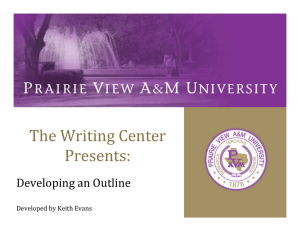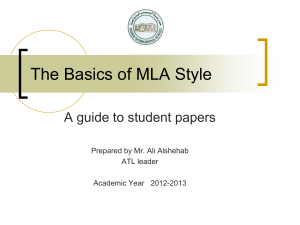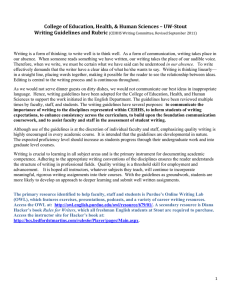PowerPoint
advertisement
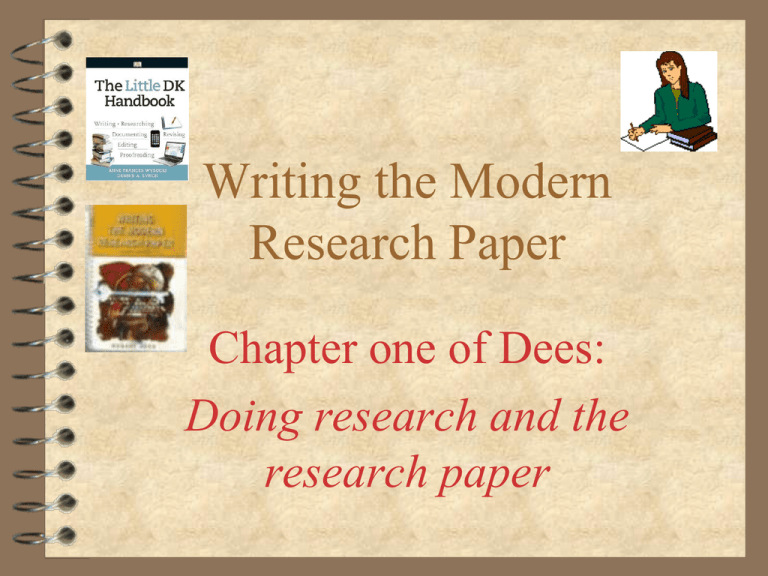
Writing the Modern Research Paper Chapter one of Dees: Doing research and the research paper Research Is. .. Observation and critical study: it is collecting information in order to make judgements and gain truth. Research is. .. Learning! Learning how to learn on your own. Learning something NEW Avoid the “old hat” What is a Research Paper’s Purpose? To inform the reader about the research topic. To demonstrate the validity or reasonableness of the author’s conclusions about the topic. Elements of the Research Paper: The Research Topic: – A particular aspect of a larger field of knowledge. – Subject > Topic > Research Question > Thesis A Respectable Length: – Longer than most papers you have had to write before. – We will expect 6 to 8 pages. – Dr. Rearick prefers 12 font in Time Roman style (he does not know why—his eyes like it). Continuing Elements of the Research Paper in MLA: Overall Organization – Title page (not usually but for this time) – Thesis and Outline (not ususlly for this time) – Text – Notes – Works Cited – Appendix http://owl.english.purdue.edu/owl/resource/747/01/ Continuing Elements of the Research Paper in APA: Overall Organization – Title page – Abstract (please include a thesis and outline too) – Main Body – References – Appendix http://owl.english.purdue.edu/owl/resource/560/1/ Continuing Elements of the Research Paper: Textual Organization – Introduction – Body – Conclusion – Works Cited or References Although these sections should all exist in MLA they are not overtly indicated by a heading. APA does divide by heading. Doing Research for Your Paper To research a subject is to “see it another way” Gather original information Evaluate from your own point of view and experience Finding Sources Primary Sources Secondary Sources Your own Encyclopedias experiences Field observations Interview Laboratory report Diaries Literary Works Letters Magazines Books Newspapers Online sources Computer database Documenting Sources means acknowledging. . . Who was the source of the information. – The author – The editor Where the scholar found the information – The Work – The Book – The publisher – The date – The page Planning a Research Schedule Investigating one or more potential research subject. Selecting a topic and framing a research question. Establishing a preliminary bibliography Devising an outline and tentative thesis statement. The Research Schedule Continued: Writing the paper Listing the works cited REVISING and editing – (get another outside reader!) Keeping a Research Notebook Dedicate a portion of your notebook for the task Use pencil or ink to record ideas and information--write clearly. Record names, titles and other bibliographic data accurately and fully to avoid errors. Use as many heading or subtitles in the notebook as need to keep your entries organized Date each entry. Once the Process is started, it can not be altered. Wrong! Plan on your mind going in different directions.
